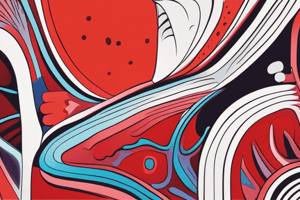Podcast
Questions and Answers
What type of tissue is primarily found in the red pulp of the spleen?
What type of tissue is primarily found in the red pulp of the spleen?
- Muscle tissue
- Fibrous tissue
- Lymphatic tissue
- Blood-filled tissue (correct)
Which structure is NOT connected to the hilum of the spleen?
Which structure is NOT connected to the hilum of the spleen?
- Lymph vessels
- Splenic vein
- Splenic artery
- Hepatic artery (correct)
During an immune response, how do T- and B-lymphocytes in the spleen react to antigens?
During an immune response, how do T- and B-lymphocytes in the spleen react to antigens?
- They break down bacteria
- They inhibit the immune response
- They migrate to lymph nodes
- They undergo proliferation (correct)
What is one of the main functions of the spleen in relation to blood cells?
What is one of the main functions of the spleen in relation to blood cells?
When does the thymus gland begin to atrophy?
When does the thymus gland begin to atrophy?
What is the maximum weight of the thymus gland at puberty?
What is the maximum weight of the thymus gland at puberty?
Which of the following statements is true regarding the storage capacity of the spleen?
Which of the following statements is true regarding the storage capacity of the spleen?
What is the primary role of macrophages found in the spleen?
What is the primary role of macrophages found in the spleen?
Flashcards
Red pulp
Red pulp
A type of tissue in the spleen, packed with blood, involved in removing old and damaged red blood cells.
White pulp
White pulp
A type of tissue in the spleen, containing immune cells (lymphocytes and macrophages) that surround blood vessels. It helps fight infections.
Splenic artery
Splenic artery
The main artery supplying blood to the spleen, branching from the celiac artery.
Splenic vein
Splenic vein
Signup and view all the flashcards
Phagocytosis (in the spleen)
Phagocytosis (in the spleen)
Signup and view all the flashcards
Blood storage (in the spleen)
Blood storage (in the spleen)
Signup and view all the flashcards
Thymus gland
Thymus gland
Signup and view all the flashcards
Thymus gland atrophy
Thymus gland atrophy
Signup and view all the flashcards
Study Notes
Spleen Communication
- The spleen is composed of lymphocytes and macrophages, arranged in red and white pulp
- Red pulp is blood-filled, while white pulp contains lymphatic tissue with lymphocytes and macrophages
- Structures entering/leaving the spleen at the hilum include the splenic artery (branch of the coeliac artery), splenic vein (branch of the portal vein), and lymph vessels (efferent only)
- Blood flows through the spleen's sinusoids, allowing close contact with splenic tissue for functions
- This function is vital in removing aged or damaged blood cells
Spleen Functions
- Phagocytosis: The spleen breaks down old or abnormal red blood cells, returning iron and bilirubin to the liver through the portal vein. It also removes other cellular materials like bacteria, leukocytes, and platelets.
- Blood storage: The spleen holds up to 350 mL of blood and can rapidly return it to circulation during emergencies (e.g., haemorrhage) by sympathetic stimulation.
- Immune response: The spleen contains T and B lymphocytes, activated by antigens, like during infections. Such activation can lead to spleen enlargement (splenomegaly) if the infection is severe.
Thymus Gland
- Location: Upper mediastinum, behind sternum, extending into the neck root.
- Dimensions (birth): ~10-15 grams
- Growth: Continues growing until puberty
- Puberty atrophy: Decreases in size and weight after puberty
- Adult weight: ~30-40 grams
- Age-related return to birth weight: By middle age, it has similar weight to birth
Studying That Suits You
Use AI to generate personalized quizzes and flashcards to suit your learning preferences.




